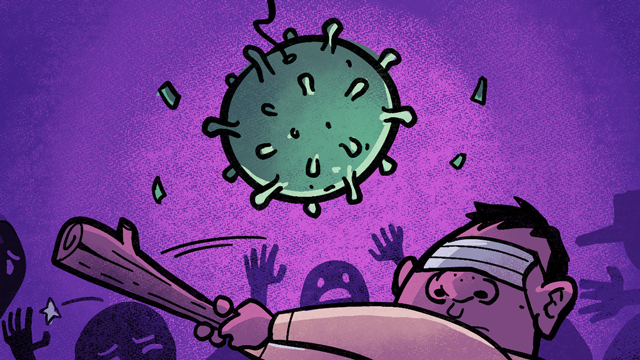SUMMARY
This is AI generated summarization, which may have errors. For context, always refer to the full article.
![[ANALYSIS] How Duterte failed to meet the Bayanihan Law’s objectives](https://www.rappler.com/tachyon/r3-assets/612F469A6EA84F6BAE882D2B94A4B421/img/F2FEFD8961EC41E893BFA12500BC92F2/bayanihan-640.jpg)


The law came and went, yet things are worse than ever.
On March 25 – almost 8 weeks since the first case of COVID-19 in the Philippines was confirmed – President Rodrigo Duterte signed into law the Bayanihan to Heal as One Act (Republic Act 11469).
The Bayanihan Law was supposed to give Duterte “special powers” to “optimize” his efforts in the pandemic response.
Nearly a hundred days since its enactment, the Bayanihan Law expired on Thursday, June 25. It’s as good a time as any to look back and ask: did Duterte meet the Bayanihan Law’s 8 policy objectives?
Let’s go through them one by one.
1) “Mitigate, if not contain, the transmission of COVID-19”
Even with special powers, Duterte emphatically failed to flatten the curve.
Rather than steadily diminish over time, the epidemic curve plateaued in April and May and even jumped to new heights in June (see graph below).
Cumulative cases have now breached 33,000, close to reaching 40,000 by end of June as predicted by some researchers.
Had the government done nothing, sure, things could’ve been a lot worse. But Duterte and his minions have also taken to comparing the Philippines with other countries in much direr situations, like the US where cases have already topped 2.4 million.
These are unfair comparisons. One should look instead at ASEAN, where we now have both the highest rate of active cases and the lowest rate of recovery. Why are we lagging behind our neighbors?
We can’t hope to mitigate the pandemic without proper data. Yet we’re also blindsided by unreliable statistics and the lack of proper targets. (READ: The dirty data, misleading graphs that muddle Duterte’s pandemic response)
2) “Immediately mobilize assistance in the provision of basic necessities to families and individuals affected by the imposition of community quarantine, especially indigents and their families”
The Bayanihan Law spawned a number of aid programs, most prominent of which is an emergency subsidy program (ESP) which sought to pay out P5,000 to P8,000 to each of 18 million households nationwide, good for two months.
June is already drawing to a close, yet government is still scrambling to distribute the second tranche for May. The first tranche for April was also derailed by a ton of logistical problems. (READ: Duterte’s coronavirus aid: Too little, too slow, too politicized)
Access to basic necessities has also been hampered by Duterte’s excessive reliance on militaristic lockdowns, sometimes imposed with little to no warning. Most recently, on June 23, quarantine passes in Cebu City were revoked in the middle of the night.
3) “Undertake measures that will prevent the overburdening of the healthcare system”
Flattening the curve is crucial because it buys us time and prevents our hospitals from being overwhelmed.
Despite the unsettling spike of new cases of late, only 36% of hospital beds nationwide were occupied as of June 23.
But the situation is highly uneven across the regions. In Cebu City, the next big hot spot, as much as 78% of beds were occupied on June 23, putting critical care capacity in Central Visayas firmly in the “warning zone.”
Some places, mostly in the Visayas, which previously had few cases are now reporting disturbing spikes – thanks to ill-timed programs like Balik Probinsya and Hatid Probinsya which unwittingly ferried to the provinces individuals who later tested positive.
4) “Immediately and amply provide healthcare, including medical tests and treatments, to COVID-19 patients, persons under investigation (PUIs), or persons under monitoring (PUMs)”
In a recent briefing, testing czar Vince Dizon trumpeted that government’s testing capacity has climbed to 51,302 as of June 19 – more than 25 times the supposed testing capacity in March. Total tests conducted also reached 612,571 as of June 22.
But Dizon didn’t report data on daily tests, which are more crucial. On June 19, government conducted only 15,201 tests – far fewer than total capacity that day.
A million more testing kits supposedly arrived on June 21, and Dizon bumped up government’s target tests to 50,000 a day. But before committing to even loftier targets, they first need to resolve the severe underutilization of testing capacity.
Besides testing, there’s also a yawning shortage of contact tracers: we need about 135,000 but we only had 52,000 as of June 18.
On top of all these, Health Secretary Francisco Duque III is facing an investigation by the Ombudsman due to allegedly delayed and overpriced procurement of personal protective equipment (among other anomalies).
5) “Undertake a program for recovery and rehabilitation including a social amelioration program and provision of safety nets to all affected sectors”
Duterte’s special powers have done little to prevent the suffering of many sectors, including locally stranded individuals who slept under an expressway as they awaited flights back home, overseas Filipino workers (OFWs) locked up in quarantine facilities for months on end, OFWs abroad now scavenging and selling their blood just to survive, persons with disability not finding their names on lists of aid beneficiaries, and jeepney drivers reduced to begging for alms on the streets they once plied.
The pandemic has spotlighted huge gaps in the country’s social safety nets. Some people are advocating universal basic income during national emergencies like this. But this proposal has largely fallen on deaf ears. (READ: Free money for every Filipino, at least during emergencies)
The National Economic and Development Authority did come up with a detailed recovery plan called “We Recover as One.” But it remains to be seen how this will play out.
6) “Ensure that there is sufficient, adequate and readily available funding to undertake the foregoing”
We kept hearing from Duterte “walang pera” (there’s no money). At least at the start, this was true: for some time now government has been operating on a budget deficit, meaning it’s spending more than it’s earning.
But in recent weeks government has managed to raise at least P340 billion from new loans, grants, and bond issuances – to speak nothing of the P300 billion infusion from the Bangko Sentral ng Pilipinas in March. (READ: Duterte’s new COVID-19 loans: Need we worry?)
Clearly, government has some money now. More worrisome is how they’ll spend it: so far there’s reason to believe they’ve failed to spend as much as they should have.
Even more money could be had if only Duterte diverted funds for Build, Build, Build to Test, Trace, and Treat. The Bayanihan Law would’ve allowed him to do so.
But his economic managers have adamantly refused to touch said infrastructure budget, saying – rather misleadingly – that Build, Build, Build will be our economic deliverance. (READ: Why we can’t Build, Build, Build our way out of this pandemic)
7) “Partner with the private sector and other stakeholders to deliver these measures and programs quickly and efficiently”
Absent mass or widespread testing shouldered by government, many private companies have taken it upon themselves to test their employees, give them aid, and keep them on the payroll for as long as possible.
But the private sector can only help themselves to a certain extent. Government must step in and help aggressively. Sadly, aid has been wanting. Even deep-pocketed companies (including some airlines) are starting to lay off their workers.
Duterte and his ilk have also taken to blaming private citizens for their supposed lack of discipline. DILG Secretary Eduardo Año said COVID-19 cases won’t spike if only people will cooperate. Duterte called Cebuanos “stubborn,” “complacent,” and “slow to move.”
But it was in fact government that was stubborn, complacent, and slow to move – especially back in January and February. Government did not take the pandemic threat seriously, did not implement mass testing and contact tracing, and did not restrict flights especially those from China.
Ranking officials – including a senator and Metro Manila’s police chief – have also been caught flouting quarantine rules. Filipinos have obediently toed the line even as some officials couldn’t bring themselves to do so.
8) “Promote and protect the collective interests of all Filipinos in these challenging times”
At the end of the day, the Bayanihan Law was meant to improve Filipinos’ welfare during this pandemic. Given the above, it’s hard to conclude that.
Far from being proactive, orderly, and based on clean, reliable data, Duterte’s pandemic response has largely been reactive, chaotic, and based on murky, unreliable data. It’s been a veritable buffet of bad policies.
This botched pandemic response not only cost us thousands of Filipinos’ health and lives, but also strongly argues against any extension of Duterte’s “special powers” whatsoever.
Hopefully, policies can still improve in the coming months. May God help us all until a vaccine is found. – Rappler.com
The author is a PhD candidate and teaching fellow at the UP School of Economics. His views are independent of the views of his affiliations. Follow JC on Twitter (@jcpunongbayan) and Usapang Econ (usapangecon.com).
Add a comment
How does this make you feel?
There are no comments yet. Add your comment to start the conversation.